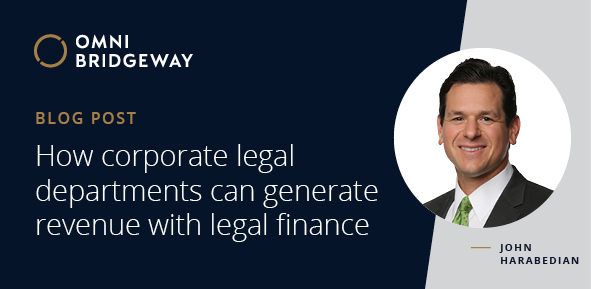How corporate legal departments can generate revenue with legal finance

- Author:
- John Harabedian
- Investment Manager and Legal Counsel - United States
For corporate legal departments, legal finance is increasingly serving as a formidable financial tool for generating revenue while reducing the costs and risks associated with bringing litigation.
During the last decade, many in-house counsel have sought ways to transform their law departments from pure cost centers to revenue generators, ultimately helping rather than hurting the bottom line.
Still, some in-house teams may hesitate to consider their company’s affirmative claims as potential revenue-generating opportunities, even when those claims are highly meritorious and could generate a windfall for the company through a large recovery for various reasons, including risk of loss, budget and claim-value uncertainty, and high costs.
Why companies may avoid affirmative litigation
Risk is one factor staying their hands: Litigation is expensive, and outcomes cannot be guaranteed. Law department budgets are often tight, and most dollars are dedicated to defense-side matters and transactional and regulatory work. And even when a company is interested in pursuing affirmative litigation, it can face difficulty in assessing the potential value and success of its claims.
Corporate accounting rules can also make pursuing litigation unattractive. Under generally accepted accounting principles (GAAP), companies must book litigation expenses as soon as they occur, but they are not allowed to treat potential recoveries as an asset on the corporate balance sheet. And when a successful recovery does occur, the income may not be included in the company’s regular revenues.
Transforming litigation into an asset with legal finance
What legal departments are discovering, however, is that many of the traditional challenges associated with bringing meritorious litigation are dramatically reduced or even eliminated by utilizing legal finance.
Generally speaking, funders make non-recourse investments in large commercial disputes brought by companies and individuals, and the funder receives a return on its investment based upon the eventual recovery. Because financing is non-recourse, the funder only gets paid if the case is successful. This solves a critical issue for companies worried about risking capital: The return the funder receives comes from money generated by the case, not from the company’s coffers.
Moreover, funding allows companies to remove litigation expenses from the balance sheet and enhance revenues. Dollars the company might have used to pursue a case are utilized for other legal matters or to pursue important company priorities. Litigation is, therefore, immediately transformed from an expense to a revenue-generating asset long before the case is resolved.
A funding arrangement also solves one of the most difficult aspects of litigation for companies—budgeting certainty. While litigation outcomes cannot be guaranteed, funding allows the company to better anticipate legal costs and insulates it from the unexpected spikes in spending that can occur during the litigation process.
A way to afford the best lawyers and incentivize risk sharing
With legal finance, a company can hire its preferred counsel and experts to pursue a matter. Many in-house leaders would like their outside law firms to take on additional risk through contingency arrangements. With funding, a law firm may take a portion of its fees as a contingency to share in the upside of a large recovery. The funder then covers the balance of the firm’s fees and expenses.
This hybrid approach means the firm or the company will not be left with all of the risk should a claim fail. And for the company, the arrangement often has the benefit of a full contingency arrangement, with most litigation expenses either handled by the funder or the law firm. In addition, the law firm is incentivized to seek the largest possible recovery, aligning its needs more closely with those of its client, and reducing the risk of the opposing side attempting to force a premature, low-ball settlement.
Valuing assets and creating litigation portfolios
Working with a funder also allows companies to properly value their litigation assets. Top funders are staffed with litigation and finance professionals who are experts at evaluating litigation claims and selecting cases for investment that have a high likelihood of success. Their due diligence can give in-house legal teams comfort about the potential outcome of a case and the size of potential recoveries.
The diligence process—usually conducted at the funder’s expense—can serve as a useful resource for a company in another way. Without spending a dime, the company can validate its existing litigation strategy or uncover information that can help it pursue a new strategy.
Funders can review a single case for possible investment, or they can help companies curate a portfolio of multiple plaintiff-side cases. Putting multiple cases into a portfolio and using that as collateral for the financing makes the investment less risky, and therefore more attractive, for funders and increases the amount of potential capital available to the company with improved pricing.
Legal financing: available throughout the life of a dispute
Legal finance is available at any stage of the litigation process—from the pre-filing stage all the way to the enforcement of a judgment or arbitration award—and it is used in a wide variety of commercial legal claims, including intellectual property, contract, antitrust, international arbitration matters, and insolvency-related disputes, among others.
To learn more about how corporate legal departments can use legal finance to generate revenue and contain costs, listen to this recent Chambers and Partners webinar “Reducing Corporate Legal Costs Through Litigation Funding.”
You can also learn more about dispute finance here. For more information about how we can assist claimants in a variety of commercial disputes, visit our Company Insights or contact us for a consultation to learn more about the ways we can help you and your clients unlock the value of meritorious claims.